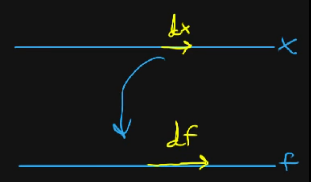Partial Derivatives
Introduction
Consider an equation with multiple variables:
$$ \begin{gather} f(x, y) = x^2y + \sin(y) \end{gather} $$How do we take the derivative of an equation such as this?
There is a method called the partial derivative which is very similar to ordinary derivatives.
We have ordinary derivatives, e.g.
$$ \begin{gather} \frac{df}{dx} \end{gather} $$And, recall the interpretation that this is the change in the function for every little change in our variable $x$.
We think of the graphical interpretation regarding slope.
Here is another interpretation where we have two lines, one for $x$ and one for $f$, and a value on one line is mapped to the value on the other line:

And, we see the change in $x$ corresponding to the change in $f$.
We can pretty much do the same thing in the multivariable world.

However, we use a different notation to emphasize that the equation is multivariable:
$$ \begin{gather} \frac{\partial f}{\partial x} \end{gather} $$This would be “partial $f$ partial $x$”. It’s partial because it doesn’t really tell the whole story of $f$.
In the case of $\frac{\partial f}{\partial x}$ it doesn’t care about $y$, it treats it as a constant. With our previous expression
$$ \begin{gather} \frac{\partial f}{\partial x}(1, 2) = \frac{\partial}{\partial x}(x^2 \cdot 2 + \sin (2))|_{x = 1}\\ = 4x + 0\\ = 4(1)\\ = 4 \end{gather} $$For $y$ we have:
$$ \begin{gather} \frac{\partial f}{\partial y}(1, 2) = \frac{\partial}{\partial y}(1 \cdot y + \sin (y))|_{y = 2}\\ = 1 + \cos(2) \end{gather} $$Obviously, we want a general formula!
Instead of plugging in a constant for the terms we aren’t interested in, we treat them as constants.
So, for $x$ we have:
$$ \begin{gather} \frac{\partial f}{\partial x} = \frac{\partial}{\partial x}(x^2y + \sin(y))\\ = 2xy \end{gather} $$And, for $y$:
$$ \begin{gather} \frac{\partial f}{\partial y} = \frac{\partial}{\partial y}(x^2y + \sin(y)\\ = x^2 + \cos(y) \end{gather} $$Sources
- Khan Academy